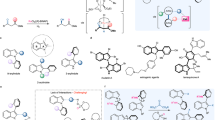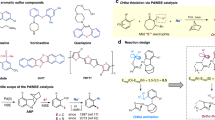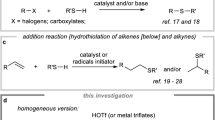Abstract
Kinetic resolution is an important method for the separation of racemates into their component enantiomers. Thiols are precursors to a variety of organosulfur compounds, with high utility in both chemistry and chemical biology, yet there is a surprising dearth of methodologies for their direct and efficient catalytic kinetic resolution. Here, we demonstrate an organocatalytic process involving the highly enantioselective desymmetrization of an achiral electrophile with the simultaneous kinetic resolution of a racemic thiol. The preparative potential of the methodology is exemplified by the synthesis of a drug precursor antipode in excellent yield and enantioselectivity as a by-product of a process that also resolves a sec-thiol substrate with a selectivity of S = 226 (that is, both thiol antipodes produced in >95% ee at 51% conversion). In a second example a racemic sec-thiol representing the stereocentre-containing core of the anti-asthma drug (R)-Montelukast was resolved with synthetically useful selectivity under mild conditions.
This is a preview of subscription content, access via your institution
Access options
Subscribe to this journal
Receive 12 print issues and online access
$259.00 per year
only $21.58 per issue
Buy this article
- Purchase on Springer Link
- Instant access to full article PDF
Prices may be subject to local taxes which are calculated during checkout


Similar content being viewed by others
References
Kagan, H. B. & Fiaud, J. C. Topics in Stereochemistry Ch. 4 (Wiley, 1988).
Vedejs, E. & Jure, M. Efficiency in non-enzymatic kinetic resolution. Angew. Chem. Int. Ed. 44, 3974–4001 (2005).
Sih, C. J. & Wu, S.-H. Topics in Stereochemistry Ch. 2 (Wiley, 1989).
Wong, C.-H. & Whitesides, G. M. Enzymes in Synthetic Organic Chemistry (Elsevier Science, 1994).
Wurz, R. Chiral dialkylaminopyridine catalysts in asymmetric synthesis. Chem. Rev. 107, 5570–5595 (2007).
Sano, T., Imai, K., Ohashi, K. & Oriyama, T. Catalytic asymmetric acylation of racemic secondary alcohols with benzoyl chloride in the presence of achiral diamine. Chem. Lett. 265–266 (1999).
Miller, S. J., Copeland, G. T., Papaioannou, N., Horstmann, T. E. & Ruel, E. M. Kinetic resolution of alcohols catalyzed by tripeptides containing the N-alkylimidazole substructure. J. Am. Chem. Soc. 120, 1629–1630 (1998).
Ishihara, K., Kosugi, Y. & Akakura, M. Rational design of an l-histidine-derived minimal artificial acylase for the kinetic resolution of racemic alcohols. J. Am. Chem. Soc. 126, 12212–12213 (2004).
Birman, V. B. & Li, X. Benzotetramisole: a remarkably enantioselective acyl transfer catalyst. Org. Lett. 7, 1351–1354 (2006).
Fu, G. C. Asymmetric catalysis with ‘planar-chiral’ derivatives of 4-(dimethylamino)pyridine. Acc. Chem. Res. 37, 542–547 (2004).
France, S., Guerin, D. J., Miller, S. J. & Lectka, T. Nucleophilic chiral amines as catalysts in asymmetric synthesis. Chem. Rev. 103, 2985–3012 (2003).
Vedejs, E., Daugulis, O., MacKay, J. A. & Rozners, E. Enantioselective acyl transfer using chiral phosphine catalysts. Synlett 1499–1505 (2001).
Spivey, A. C., Maddaford, A. & Redgrave, A. J. Asymmetric catalysis of acyl transfer by Lewis acids and nucleophiles. A review. Org. Prep. Proc. Int. 32, 331–365 (2000).
Connon, S. J. Catalytic asymmetric acyl-transfer mediated by chiral pyridine derivatives. Lett. Org. Chem. 3, 333–338 (2006).
Thuillier, A. & Metzner, P. Sulfur Reagents in Organic Synthesis (Academic Press, 1994).
Chatgilialoglu, C. & Asmus, K.-D. Sulfur-Centered Reactive Intermediates in Chemistry and Biology (Springer, 1991).
Berg, J. M., Tymoczko J. L. & Stryer, L. Biochemistry 5th edn (Freeman, 2002).
Moran, L. K., Gutteridge, J. M. & Quinlan, G. J. Thiols in cellular redox signalling and control. Curr. Med. Chem. 8, 763–762 (2001).
Pachamuthu, K. & Schmidt, R. R. Synthetic routes to thiooligosaccharides and thioglycopeptides. Chem. Rev. 106, 160–187 (2006).
Fronza, G., Fuganti, C., Grasselli, P., Pedrocchi-Fantoni, G. & Servi, S. Minor synthetic capacities of baker's yeast towards unnatural substrates. Pure Appl. Chem. 64, 1099–1101 (1992).
Bianchi, D. & Cesti, P. Lipase-catalyzed stereoselective thiotransesterification of mercapto esters. J. Org. Chem. 55, 5657–5659 (1990).
Öhrner, N., Orrenius, C., Mattson, A., Norin, T. & Hult, K. Kinetic resolutions of amine and thiol analogues of secondary alcohols catalyzed by the Candida Antarctica lipase B. Enz. Microb. Tech. 19, 328–331 (1996).
Strijtveen, B. & Kellogg, R. M. Synthesis of (racemization prone) optically active thiols by SN2 substitution using cesium thiocarboxylates. J. Org. Chem. 51, 3664–3671 (1986).
Connon, S. J. Asymmetric catalysis with bifunctional cinchona alkaloid-based urea and thiourea organocatalysts. Chem. Commun. 2499–2510 (2008).
Spivey, A. C. & Andrews, B. I. Catalysis of the asymmetric desymmetrization of cyclic anhydrides by nucleophilic ring-opening with alcohols. Angew. Chem. Int. Ed. 40, 3131–3134 (2001).
Atodiresei, I., Schiffers, I. & Bolm, C. Stereoselective anhydride openings. Chem. Rev. 107, 5683–5712 (2007).
Chen, Y., McDaid, P. & Deng, L. Asymmetric alcoholysis of cyclic anhydrides. Chem. Rev. 103, 2965–2984 (2003).
Tian, S.-K., Chen, Y., Hang, J., Tang, L., McDaid, P. & Deng, L. Asymmetric organic catalysis with modified cinchona alkaloids. Acc. Chem. Res. 37, 621–631 (2004).
Peschiulli, A., Gun'ko, Y. & Connon, S. J. Highly enantioselective desymmetrization of meso anhydrides by a bifunctional thiourea-based organocatalyst at low catalyst loadings and room temperature. J. Org. Chem. 73, 2454–2457 (2008).
Peschiulli, A., Quigley, C., Tallon, S., Gun'ko, Y. K. & Connon, S. J. Organocatalytic asymmetric addition of alcohols and thiols to activated electrophiles: efficient dynamic kinetic resolution and desymmetrization protocols. J. Org. Chem. 73, 6409–6412 (2008).
Honjo, T., Sano, S., Shiro, M. & Nagao, Y. Highly enantioselective catalytic thiolysis of prochiral cyclic dicarboxylic anhydrides utilizing a bifunctional chiral sulfonamide. Angew. Chem. Int. Ed. 44, 5838–5841 (2005).
Rho, H. S. et al. Bifunctional organocatalyst for methanolytic desymmetrization of cyclic anhydrides: increasing enantioselectivity by catalyst dilution. Chem. Commun. 1208–1210 (2008).
Oh, S. H. et al. A highly reactive and enantioselective bifunctional organocatalyst for the methanolytic desymmetrization of cyclic anhydrides: prevention of catalyst aggregation. Angew. Chem. Int. Ed. 47, 7872–7875 (2008)
Hoekstra, M. S. et al. Chemical development of CI-1008, an enantiomerically pure anticonvulsant. Org. Proc. Res. Dev. 1, 26–38 (1997).
Silverman, R. B. From basic science to blockbuster drug: the discovery of Lyrica. Angew. Chem. Int. Ed. 47, 2–7 (2008).
Hiratake, J., Inagaki, M., Yamamoto, Y. & Oda, J. Enantiotopic-group differentiation. Catalytic asymmetric ring-opening of prochiral cyclic acid anhydrides with methanol, using cinchona alkaloids. J. Chem. Soc. Perkin. Trans. 1 1053–1058 (1987).
Jaeschke, G. & Seebach, D. Highly enantioselective ring opening of cyclic meso-anhydrides to isopropyl hemiesters with Ti–TADDOLates: an alternative to hydrolytic enzymes? J. Org. Chem. 63, 1190–1197 (1998).
Bolm, C., Schiffers, I., Dinter, C. L. & Gerlach, A. Practical and highly enantioselective ring opening of cyclic meso-anhydrides mediated by cinchona alkaloids. J. Org. Chem. 65, 6984–6991 (2000).
Chen, Y., Tian, S.-K. & Deng, L. A highly enantioselective catalytic desymmetrization of cyclic anhydrides with modified cinchona alkaloids. J. Am. Chem. Soc. 122, 9542–9543 (2000).
Cook, M. J. & Rovis, T. Rhodium-catalyzed enantioselective desymmetrization of meso-3,5-dimethyl glutaric anhydride: a general strategy to syn-deoxypolypropionate synthons. J. Am. Chem. Soc. 129, 9302–9303 (2007).
Acknowledgements
This material is based on work supported by Science Foundation Ireland, The European Research Council and The Irish Research Council for Science, Engineering and Technology.
Author information
Authors and Affiliations
Contributions
S.J.C., B.P. and A.P. designed the research. S.J.C. analysed the data and prepared the manuscript. B.P., A.P. and C.J.O'C. performed the experimental work. All authors discussed the results and commented on the manuscript.
Corresponding author
Ethics declarations
Competing interests
The authors declare no competing financial interests.
Supplementary information
Supplementary information
Supplementary information (PDF 1198 kb)
Rights and permissions
About this article
Cite this article
Peschiulli, A., Procuranti, B., O' Connor, C. et al. Synergistic organocatalysis in the kinetic resolution of secondary thiols with concomitant desymmetrization of an anhydride. Nature Chem 2, 380–384 (2010). https://doi.org/10.1038/nchem.584
Received:
Accepted:
Published:
Issue Date:
DOI: https://doi.org/10.1038/nchem.584



